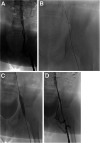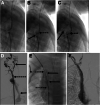Managing systemic venous occlusions in children
- PMID: 32886283
- PMCID: PMC7474020
- DOI: 10.1186/s42155-020-00150-1
Managing systemic venous occlusions in children
Abstract
Pediatric venous disease is increasing in incidence in both inpatient and outpatient populations. The widespread use of central venous access devices as well as the rising incidence of thromboembolic events in pediatrics is leading to more systemic venous occlusions in both the central and peripheral veins. This review focuses on the etiology, presentation, workup, and general technical considerations of recanalization as well as procedural complications related to pediatric systemic venous occlusive disease. The potential role for pediatric interventional radiology guided treatments will be discussed in detail.
Keywords: Endovascular stenting; Endovascular venous reconstruction; Inferior vena cava; Pediatrics; Superior vena cava; Systemic venous occlusion; Thromboembolism.
Conflict of interest statement
The authors declare that they have no competing interests.
Figures







References
Publication types
Grants and funding
LinkOut - more resources
Full Text Sources
